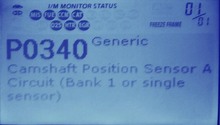Ford Mustang GT 1996-2014: Why is My ABS Light On?
Aren't you tired of dealing with skidding tires and lost of traction? It's time to turn that ABS light off, and you can use this article to learn how.
This article applies to the Ford Mustang GT (1996-2014).
The ABS in your car is used to help increase the traction of the vehicle. When the light turns on, it means there is one or more components from the brake system malfunctioning. This causes the standalone ABS computer to turn off its system, along with traction control as a safety measure. There are several things that can attribute to an ABS light turning on, such as loose wiring or faulty wheel sensors. Use this diagnosis article to help pinpoint why your ABS light has illuminated.

Materials Needed
- Test-light
- Code reader
- Flashlight
These following steps can be done in any order you so choose, as any one of these procedures has the potential to quickly fix the problem.
Step 1 – Check your fuses
The fuses might be blown.
If you are a constant reader here, you should already know! This is the number one thing to do whenever there is an electrical issue on your car. Pop open the fuse cover from the engine bay and grab your test-light. Ground the test light and check fuses 15, 29, 33, 35, ABS-1 and ABS-2. If any of the fuses are damaged, replace them with the corresponding amp rated fuse. Turn the car on and check to see if the ABS light illuminates. If it is still there, then move on to the next step.
Pro Tip
Fuses are the first form of defense for power surges or open circuits, as they'll blow before the sensor burns out. However, if you find a damaged sensor, it may mean there is another wiring issue in your harness that needs to be repaired, so you can avoid blowing the fuse again.
Step 2 – Check the wiring
Some of the circuitry may be disconnected or damaged.
Inspect the wires of the ABS circuitry. Here you can use your flashlight, in conjunction with your test-light, to see if any wires are failing to receive a signal or are burned. If you do find some burnt wires, trace them back to its specific components because the damaged wiring may point to a larger problem with the ABS module itself.

Step 3 – Check the brake fluid
You may just have low fluid.
Check your brake fluid! If the fluid is too low, your ABS light will turn on. Also, if it is too low, it means there is a leak in your brake system, which will need to be found and repaired.

Step 4 – Run a coder reader
You will have a code triggered.
Most of the time, if the ABS light is on, it means a code has been triggered. Locate the data plug connector located under the instrumental panel of the vehicle. Connect the code reader and press the scan button, then observe the results. Depending on the type of code reader you have, it will define the code and tell you the procedures required to repair it. After diagnosing the code, complete the repair and check the ABS light.

Related Discussions
- ABS Light / Traction Control Off - MustangForums.com
- Trc Cntrl/Abs light stuck on..need help!!! - MustangForums.com
- ABS Light On - MustangForums.com
- ABS Light On, How to Check - MustangForums.com






